Soil Liquefaction and Other Seismic-Associated Phenomena in the City of Chone during the 2016 Earthquake of Coastal Ecuador
Abstract
1. Introduction
2. The Study Area
2.1. Geodynamic and Geomorphological Setting
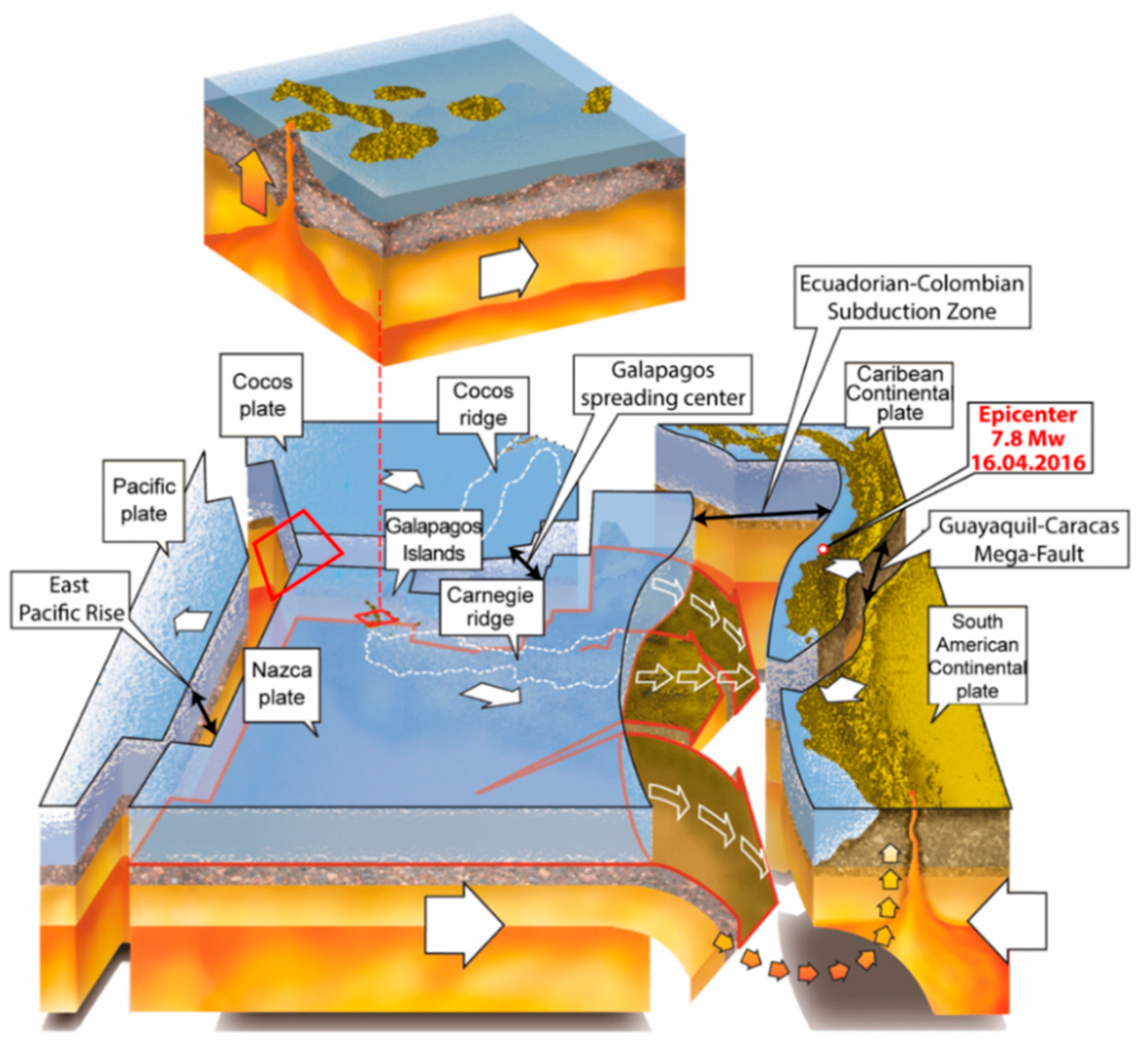
| Sector (Epicenter) | Date | Magnitude (Mw) |
|---|---|---|
| Bahía de Caráquez | 3 May 1896 | 7.1 |
| Esmeraldas | 31 January 1906 | 8.8 |
| Pedernales-Muisne | 1 June 1907 | 7.4 |
| Pedernales | 14 May 1942 | 7.9 |
| Esmeraldas | 23 October 1944 | 6.7 |
| Bahía de Caráquez | 16 January 1956 | 7.4 |
| Esmeraldas | 19 January 1958 | 7.6 |
| Bahía de Caráquez | 4 August 1998 | 7.1 |
| Pedernales | 16 April 2016 | 7.8 |
2.2. Structural Geological Context of the Studied Area
| Figure 100. | Mechanism | Fault Length (km) | Fault Depth (km) | Distance Fault to City (km) | Rake | Fault Width (km) | Magnitude Calculated 100% Fault Rupture Length | Magnitude Calculated 60% Fault Rupture Length | Levels of Reliability | PGA-Rock (g) |
|---|---|---|---|---|---|---|---|---|---|---|
| F01 | Normal | 39 | 16 | 95 | −90 | 10 | 6.87 | 6.76 | deducted | 0.32 |
| F02 | Normal | 29 | 15 | 78 | −90 | 9 | 6.81 | 6.70 | deducted | 0.32 |
| F03 | Normal | 27 | 15 | 62 | −90 | 9 | 6.79 | 6.69 | deducted | 0.32 |
| F04 | Shear fault Sx | 33 | 15 | 73 | −5 | 10 | 6.88 | 6.69 | deducted | 0.33 |
| F05 | Normal | 16 | 12 | 102 | −90 | 8 | 6.69 | 6.58 | deducted | 0.34 |
| F06 | Normal | 21 | 12 | 113 | −90 | 8 | 6.74 | 6.64 | deducted | 0.35 |
| F07 | Reverse | 43 | 16 | 92 | 90 | 10 | 7.18 | 6.76 | certain | 0.36 |
| F08 | Normal | 16 | 12 | 43 | −90 | 8 | 6.69 | 6.58 | certain | 0.34 |
| F09 | Reverse | 17 | 12 | 28 | 90 | 8 | 6.42 | 6.01 | certain | 0.31 |
| F10 | Normal | 25 | 15 | 9 | −90 | 9 | 6.78 | 6.67 | deducted | 0.32 |
| F11 | Reverse | 22 | 15 | 33 | 90 | 8 | 6.63 | 6.22 | certain | 0.30 |
| F12 | Reverse | 38 | 16 | 26 | 90 | 10 | 7.08 | 6.66 | deducted | 0.35 |
| F13 | Normal | 44 | 16 | 46 | −90 | 10 | 6.89 | 6.79 | certain | 0.32 |
| F14 | Normal | 31 | 15 | 70 | −90 | 9 | 6.82 | 6.72 | certain | 0.32 |
| F15 | Shear fault Dx | 15 | 12 | 40 | −175 | 8 | 6.58 | 6.39 | deducted | 0.33 |
| F16 | Shear fault Dx | 25 | 15 | 32 | −175 | 9 | 6.78 | 6.58 | certain | 0.32 |
| F17 | Reverse | 13 | 12 | 52 | 90 | 7 | 6.20 | 5.79 | certain | 0.28 |
| F18 | Shear fault Sx | 7 | 10 | 38 | −5 | 6 | 6.30 | 6.10 | certain | 0.32 |
| F19 | Reverse | 18 | 15 | 52 | 90 | 8 | 6.47 | 6.05 | deducted | 0.28 |
| F20 | Shear fault Sx | 5 | 10 | 58 | −5 | 6 | 6.17 | 5.98 | certain | 0.31 |
| F21 | Normal | 16 | 12 | 5 | −90 | 8 | 6.69 | 6.,58 | deducted | 0.34 |
2.3. Geological and Geotechnical Section of the Lithological Structure of the Chone Soil

3. Materials and Methods
4. Results and Discussion
4.1. Geological and Geotechnical Database

4.2. Determination of the Safety Factor for the City of Chone
4.3. Analysis of the Liquefaction Potential in the City of Chone
| Liquefaction Potential Category | Iwasaki et al. [61] | Sonmez [62] |
|---|---|---|
| Very low | LPI = 0 | No liquefiable (based on Fs ≥ 1.2) |
| Low | 0 < LPI < 5 | 0 < LPI < 2 |
| Moderate | - | 2 < LPI < 5 |
| High | 5 < LPI < 15 | 5 < LPI < 15 |
| Very high | LPI > 15 | LPI > 15 |
| Description (Likelihood of Liquefaction) | Class | Borehole | PL | Fs |
|---|---|---|---|---|
| Almost certain that it will liquefy | 5 | BH01 | 0.979 | 0.409 |
| Almost certain that it will liquefy | 5 | BH02 | 0.987 | 0.365 |
| Almost certain that it will liquefy | 5 | BH03 | 0.989 | 0.350 |
| Almost certain that it will liquefy | 5 | BH04 | 0.998 | 0.240 |
| Almost certain that it will liquefy | 5 | BH05 | 0.998 | 0.236 |
| Almost certain that it will liquefy | 5 | BH06 | 0.999 | 0.214 |
| Almost certain that it will liquefy | 5 | BH07 | 0.999 | 0.214 |
| Almost certain that it will liquefy | 5 | BH08 | 0.979 | 0.408 |
| Liquefaction/non-liquefaction is equally likely | 3 | BH09 | 0.401 | 1.050 |
| Liquefaction/non-liquefaction is equally likely | 3 | BH10 | 0.430 | 1.022 |
| Liquefaction/non-liquefaction is equally likely | 3 | BH11 | 0.487 | 0.971 |
| Liquefaction/non-liquefaction is equally likely | 3 | BH12 | 0.373 | 1.077 |
| Liquefaction/non-liquefaction is equally likely | 3 | BH13 | 0.573 | 0.899 |
| Liquefaction/non-liquefaction is equally likely | 3 | BH14 | 0.547 | 0.921 |
| Very likely | 4 | BH15 | 0.684 | 0.809 |
| Unlikely | 2 | BH16 | 0.236 | 1.246 |
| Unlikely | 2 | BH17 | 0.260 | 1.210 |
| Liquefaction/non-liquefaction is equally likely | 3 | BH18 | 0.435 | 1.017 |
| Very likely | 4 | BH19 | 0.920 | 0.558 |
| Almost certain that it will liquefy | 5 | BH20 | 0.935 | 0.531 |
| Almost certain that it will liquefy | 5 | BH21 | 0.964 | 0.462 |
| Liquefaction/non-liquefaction is equally likely | 3 | BH22 | 0.613 | 0.867 |
| Very likely | 4 | BH23 | 0.840 | 0.664 |
| Liquefaction/non-liquefaction is equally likely | 3 | BH24 | 0.641 | 0.844 |
| Liquefaction/non-liquefaction is equally likely | 3 | BH25 | 0.637 | 0.847 |
| Almost certain that it will liquefy | 5 | BH26 | 0.932 | 0.536 |
| Probability of Liquefaction PL | Description (Likelihood of Liquefaction) | Security Factor Fs | Class |
|---|---|---|---|
| 0.989 | Almost certain that it will liquefy | 0.354 | 5 |
| 0.849 | Very likely | 0.654 | 4 |
| 0.530 | Liquefaction/non-liquefaction is equally likely | 0.935 | 3 |
| 0.248 | Unlikely | 1.228 | 2 |
| * | Almost certain that it will not liquefy | * | 1 |
4.4. Liquefaction Susceptibility Map, with Maximum Estimates of Magnitude Mw and PGA Values for the City of Chone
5. Conclusions
Author Contributions
Funding
Institutional Review Board Statement
Informed Consent Statement
Data Availability Statement
Acknowledgments
Conflicts of Interest
References
- Kanamori, H. The energy release in great earthquakes. J. Geophys. Res. 1977, 82, 2981–2987. [Google Scholar] [CrossRef]
- Calais, E.; Camelbeeck, T.; Stein, S.; Liu, M.; Craig, T.J. A new paradigm for large earthquakes in stable continental plate interiors. Geophys. Res. Lett. 2016, 43, 10–621. [Google Scholar] [CrossRef]
- Dixit, J.; Dewaikar, D.M.; Jangid, R.S. Assessment of liquefaction potential index for Mumbai city. Nat. Hazards Earth Syst. Sci. 2012, 12, 2759–2768. [Google Scholar] [CrossRef]
- Papathanassiou, G.; Pavlides, S.; Ganas, A. The 2003 Lefkada earthquake: Field observations and preliminary microzonation map based on liquefaction potential index for the town of Lefkada. Eng. Geol. 2005, 82, 12–31. [Google Scholar] [CrossRef]
- Mohindra, R.; Bagati, T.N. Seismically induced soft-sediment deformation structures (seismites) around Sumdo in the lower Spiti valley (Tethys Himalaya). Sediment. Geol. 1996, 101, 69–83. [Google Scholar] [CrossRef]
- Hernández, E.H.O.; Moncayo, E.H.O.; Sánchez, L.K.M.; de Calderero, R.P. Behavior of clayey soil existing in the portoviejo canton and its neutralization characteristics. Int. Res. J. Eng. IT Sci. Res. 2017, 3, 1–10. [Google Scholar] [CrossRef][Green Version]
- Obermeier, S.F.; Olson, S.M.; Green, R.A. Field occurrences of liquefaction-induced features: A primer for engineering geologic analysis of paleoseismic shaking. Eng. Geol. 2005, 76, 209–234. [Google Scholar] [CrossRef]
- Okamura, M.; Bhandary, N.P.; Mori, S.; Marasini, N.; Hazarika, H. Report on a reconnaissance survey of damage in Kathmandu caused by the 2015 Gorkha Nepal earthquake. Soils Found. 2015, 55, 1015–1029. [Google Scholar] [CrossRef]
- Javdanian, H. Evaluation of soil liquefaction potential using energy approach: Experimental and statistical investigation. Bull. Eng. Geol. Environ. 2019, 78, 1697–1708. [Google Scholar] [CrossRef]
- Javadi, A.A.; Rezania, M.; Nezhad, M.M. Evaluation of liquefaction induced lateral displacements using genetic programming. Comput. Geotech. 2006, 33, 222–233. [Google Scholar] [CrossRef]
- Rahman, M.; Siddiqua, S. Evaluation of liquefaction-resistance of soils using standard penetration test, cone penetration test, and shear-wave velocity data for Dhaka, Chittagong, and Sylhet cities in Bangladesh. Environ. Earth Sci. 2017, 76, 207. [Google Scholar] [CrossRef]
- Kayabali, K. Soil liquefaction evaluation using shear wave velocity. Eng. Geol. 1996, 44, 121–127. [Google Scholar] [CrossRef]
- Toprak, S.; Holzer, T.L. Liquefaction potential index: Field assessment. J. Geotech. Geoenviron. Eng. 2003, 129, 315–322. [Google Scholar] [CrossRef]
- Seed, H.B.; Idriss, I.M. Simplified procedure for evaluating soil liquefaction potential. J. Soil Mech. Found. Div. 1971, 97, 1249–1273. [Google Scholar] [CrossRef]
- Bolton Seed, H.; Tokimatsu, K.; Harder, L.F.; Chung, R.M. Influence of SPT procedures in soil liquefaction resistance evaluations. J. Geotech. Eng. 1985, 111, 1425–1445. [Google Scholar] [CrossRef]
- Youd, T.L.; Idriss, I.M. Proceeding of the NCEER workshop on evaluation of liquefaction resistance of soils. In Proceedings of the NCEER Workshop on Evaluation of Liquefaction Resistance of Soils, Salt Lake City, UT, USA, 5–6 January 1997; p. 276. [Google Scholar]
- Zambrano-Rendón, V.A.; Ortiz-Hernández, E.H.; Alcívar-Moreira, W.S. Caracterización geotécnica de los suelos de la ciudad de Calceta en la provincia de Manabí. Polo Del Conoc. 2021, 6, 77–90. [Google Scholar] [CrossRef]
- Tokimatsu, K.; Yoshimi, Y. Empirical correlation of soil liquefaction based on SPT N-value and fines content. Soils Found. 1983, 23, 56–74. [Google Scholar] [CrossRef]
- Obermeier, S.F. Use of liquefaction-induced features for paleoseismic analysis—An overview of how seismic liquefaction features can be distinguished from other features and how their regional distribution and properties of source sediment can be used to infer the location and strength of Holocene paleo-earthquakes. Eng. Geol. 1996, 44, 1–76. [Google Scholar] [CrossRef]
- Seed, H.B. Soil liquefaction and cyclic mobility evaluation for level ground during earthquakes. J. Geotech. Eng. Div. 1979, 105, 201–255. [Google Scholar] [CrossRef]
- Schmertmann, J.H. Use the SPT to Measure Dynamic Soil Properties?—Yes, But.! ASTM International: West Conshohocken, PA, USA, 1978; pp. 341–355. [Google Scholar]
- Silva, A.; Montiel, P.O.L. Informe Geotécnico Final; Hospital Napoleón Dávila de Chone: Chone, Ecuador, 2016. [Google Scholar]
- Kritikos, T.; Robinson, T.R.; Davies, T.R. Regional coseismic landslide hazard assessment without historical landslide inventories: A new approach. J. Geophys. Res. Earth Surf. 2015, 120, 711–729. [Google Scholar] [CrossRef]
- Holzer, T.L.; Bennett, M.J.; Ponti, D.J.; Tinsley, J.C., III. Liquefaction and soil failure during 1994 Northridge earthquake. J. Geotech. Geoenviron. Eng. 1999, 125, 438–452. [Google Scholar] [CrossRef]
- Nakamura, S.; Wakai, A.; Umemura, J.; Sugimoto, H.; Takeshi, T. Earthquake-induced landslides: Distribution, motion and mechanisms. Soils Found. 2014, 54, 544–559. [Google Scholar] [CrossRef]
- Sonmez, H.; Gokceoglu, C. A liquefaction severity index suggested for engineering practice. Environ. Geol. 2005, 48, 81–91. [Google Scholar] [CrossRef]
- Rahman, M.Z.; Siddiqua, S.; Kamal, A.M. Liquefaction hazard mapping by liquefaction potential index for Dhaka City, Bangladesh. Eng. Geol. 2015, 188, 137–147. [Google Scholar] [CrossRef]
- Avilés-Campoverde, D.; Chunga, K.; Ortiz-Hernández, E.; Vivas-Espinoza, E.; Toulkeridis, T.; Morales-Delgado, A.; Delgado-Toala, D. Seismically Induced Soil Liquefaction and Geological Conditions in the City of Jama due to the M7. 8 Pedernales Earthquake in 2016, NW Ecuador. Geosciences 2020, 11, 20. [Google Scholar] [CrossRef]
- Salocchi, A.C.; Minarelli, L.; Lugli, S.; Amoroso, S.; Rollins, K.M.; Fontana, D. Liquefaction source layer for sand blows induced by the 2016 megathrust earthquake (Mw 7.8) in Ecuador (Boca de Briceño). J. S. Am. Earth Sci. 2020, 103, 102737. [Google Scholar] [CrossRef]
- Ortiz-Hernández, E.; Chunga, K.; Pastor, J.L.; Toulkeridis, T. Assessing Susceptibility to Soil Liquefaction Using the Standard Penetration Test (SPT)—A Case Study from the City of Portoviejo, Coastal Ecuador. Land 2022, 11, 463. [Google Scholar] [CrossRef]
- UNESCO-IOC. Expert Meeting on Tsunami Sources, Hazards, Risk and Uncertainties Associated with the Colombia-Ecuador Subduction Zone, Guayaquil, Ecuador, 27–29 January 2019; Workshop Report No.295; UNESCO: Paris, France, 2021. [Google Scholar]
- Toulkeridis, T.; Chunga, K.; Rentería, W.; Rodriguez, F.; Mato, F.; Nikolaou, S.; D’Howitt, M.C.; Besenzon, D.; Ruiz, H.; Parra, H.; et al. THE 7.8 Mw earthquake and tsunami of 16th April 2016 in Ecuador: Seismic Evaluation, Geological Field Survey and Economic Implications. Sci. Tsunami Hazards 2017, 36, 78–123. [Google Scholar]
- Zambrano, G.; Benefrido, W. Análisis de la Evolución en el Sector los Chonanas, Generado por la Construcción de la Vivienda de Interés Social. Repositorio Institucional de la Universidad San Gregorio de Portoviejo. 2021. Available online: http://repositorio.sangregorio.edu.ec/handle/123456789/2422 (accessed on 28 April 2022).
- Navia, J.; Chunga, K. Caracterización geotécnica de suelos cohesivos-granulares en la ciudad de Chone. 2020. Available online: https://www.researchgate.net/publication/353209964_Caracterizacion_geotecnica_de_suelos_cohesivos-granulares_en_la_ciudad_de_Chone (accessed on 28 April 2022).
- Charfuelán, C.; Armando, D. Geología del cuaternario de la ciudad de Portoviejo y su zona de influencia (escala 1:20000). Bachelor’s Thesis, Carrera de Ingeniería en Geología, Quito, Ecuador, 2018. [Google Scholar]
- Chunga, K. Shallow Crustal Earthquakes and Seismic Zonation for Ecuador through the Integration of Geological, Seismological and Morphostructural Data. Ph.D. Thesis, University of Insubria, Varese, Italy, 2010; p. 165. (In Italian). [Google Scholar]
- Eguez, A.; Alvarado, A.; Yepes, H.; Machette, M.N.; Costa, C.; Dart, R.L.; Bradley, L.A. Database and map of Quaternary faults and folds of Ecuador and its offshore regions. US Geol. Surv. Open-File Rep. 2003, 3, 289. [Google Scholar]
- Chunga, K.; Ochoa-Cornejo, F.; Mulas, M.; Toulkeridis, T.; Menéndez, E. Characterization of seismogenic crustal faults in the Gulf of Guayaquil, Ecuador. Andean Geol. 2019, 46, 66–81. [Google Scholar] [CrossRef]
- Wesnousky, S.G. Displacement and geometrical characteristics of earthquake surface ruptures: Issues and implications for seismic-hazard analysis and the process of earthquake rupture. Bull. Seismol. Soc. Am. 2008, 98, 1609–1632. [Google Scholar] [CrossRef]
- Fukushima, Y.; Tanaka, T. A new attenuation relation for peak horizontal acceleration of strong earthquake ground motion in Japan. Bull. Seismol. Soc. Am. 1990, 80, 757–783. [Google Scholar]
- NEC-11. Norma Ecuatoriana de la Construcción; Registro Oficial No. 413 del 10 de Enero de 2015; NEC: Tokyo, Japan, 2015. [Google Scholar]
- Chunga, K.; Pazmiño, N.; Martillo, C.; Quiñonez, M.; Huaman, F. Estimación de máximos niveles de sismicidad para el Litoral Ecuatoriano a través de la integración de datos geológicos y sismo-tectónicos. Rev. Científica Tecnológica UPSE 2013, 1. [Google Scholar] [CrossRef]
- Ritta, R.J.; Suárez, L.E.; Pando, M.A. Determinación del período fundamental del suelo usando vibración ambiental y el cociente espectral horizontal/vertical. Mecánica Comput. 2012, 31, 1399–1419. [Google Scholar]
- Chunga, K. Reconocimiento Geológico de la Ciudad de Chone. Microzonificación Sísmica de Ciudades Prioritarias de la Costa Ecuatoriana de Conformidad con los Requisitos de la Norma Ecuatoriana de la Construcción NEC; Proyecto BID # EC-T1354. Reporte Técnico 34 pág; Universidad de los Andes: Bogotá, Colombia, 2019. [Google Scholar]
- Daza, J.; Trstancho, J.; Caicedo, B. Caracterización Geotécnica y Geofísica de la Ciudad de Chone. Microzonificación Sísmica de Ciudades Prioritarias de la Costa Ecuatoriana de Conformidad con los Requisitos de la Norma Ecuatoriana de la Construcción NEC; Proyecto BID # EC-T1354; Reporte Técnico 94 pág; Universidad de los Andes: Bogotá, Colombia, 2019. [Google Scholar]
- CEC. Código Ecuatoriano de la Construcción. Requisitos Generales de Diseño: Peligro Sísmico, Espectros de Diseño y Requisitos Mínimos de Cálculos Para Diseño Sismo Resistente; Registro Oficial No. 382 de 2 de Agosto de 2001; CEC: Quito, Ecuador, 2002. [Google Scholar]
- Michetti, A.M.; Esposito, E.; Guerrieri, L.; Porfido, S.; Serva, L.; Tatevossian, R.; Vittori, E.; Audemard, F.; Azuma, T.; Clague, J. Environmental seismic intensity scale-ESI 2007. Mem. Descr. Carta Geol. D’Italia 2007, 74, 7–23. [Google Scholar]
- Yao, Y.; Chen, J.; Li, T.; Fu, B.; Wang, H.; Li, Y.; Jia, H. Soil liquefaction in seasonally frozen ground during the 2016 Mw6.6 Akto earthquake. Soil Dyn. Earthq. Eng. 2019, 117, 138–148. [Google Scholar] [CrossRef]
- Youd, T.L.; Idriss, I.M. Liquefaction resistance of soils: Summary report from the 1996 NCEER and 1998 NCEER/NSFworkshops on evaluation of liquefaction resistance of soils. J. Geotech. Geoenviron. Eng. 2001, 127, 297–313. [Google Scholar]
- Tutuz, T.; Sanver, I.E.; Adil, F. Report on Geological-Geotechnical Investigation of Inegol Municipality Settelement Area; Ankara, Turkey, 2000; 61p. [Google Scholar]
- Juang, C.H.; Chen, C.J.; Jiang, T.; Andrus, R.D. Risk-based liquefaction potential evaluation using standard penetration tests. Can. Geotech. J. 2000, 37, 1195–1208. [Google Scholar] [CrossRef]
- Goharzay, M.; Noorzad, A.; Ardakani, A.M.; Jalal, M. A worldwide SPT-based soil liquefaction triggering analysis utilizing gene expression programming and Bayesian probabilistic method. J. Rock Mech. Geotech. Eng. 2017, 9, 683–693. [Google Scholar] [CrossRef]
- Papathanassiou, G. LPI-based approach for calibrating the severity of liquefaction-induced failures and for assessing the probability of liquefaction surface evidence. Eng. Geol. 2008, 96, 94–104. [Google Scholar] [CrossRef]
- Tokimatsu, K.; Uchida, A. Correlation between liquefaction resistance and shear wave velocity. Soils Found. 1990, 30, 33–42. [Google Scholar] [CrossRef]
- Quigley, M.C.; Hughes, M.W.; Bradley, B.A.; van Ballegooy, S.; Reid, C.; Morgenroth, J.; Horton, T.; Duffy, B.; Pettinga, J.R. The 2010–2011 Canterbury earthquake sequence: Environmental effects, seismic triggering thresholds and geologic legacy. Tectonophysics 2016, 672, 228–274. [Google Scholar] [CrossRef]
- Seed, R.B.; Cetin, K.O.; Moss, R.E.; Kammerer, A.M.; Wu, J.; Pestana, J.M.; Riemer, M.F.; Sancio, R.B.; Bray, J.D.; Kayen, R.E. Recent advances in soil liquefaction engineering: A unified and consistent framework. In Proceedings of the 26th Annual ASCE Los Angeles Geotechnical Spring Seminar, Long Beach, CA, USA, 30 April 2003. [Google Scholar]
- Wang, W. Some Findings in Soil Liquefaction; Earthquake Engineering Department, Water Conservancy and Hydroelectric Power Scientific Research Institute: Beijing, China, 1979. [Google Scholar]
- Seed, H.B.; Lee, K.L. Liquefaction of saturated sands during cyclic loading. J. Soil Mech. Found. Div. 1966, 92, 105–134. [Google Scholar] [CrossRef]
- Koester, J.P. Effects of fines type and content on liquefaction potential of low-to medium plasticity fine-grained soils. In Hazard Assessment Preparedness, Awareness, and Public Education Emergency Response and Recovery Socioeconomic and Public Policy Impacts: Proceedings; U.S. Central United States Earthquake Consortium (CUSEC): Memphis, TN, USA, 1993; pp. 67–75. [Google Scholar]
- Chen, C.J.; Juang, C.H. Calibration of SPT-and CPT-based liquefaction evaluation methods. In Innovations and Applications in Geotechnical Site Characterization; American Society of Civil Engineers: Reston, VA, USA, 2000; pp. 49–64. [Google Scholar]
- Iwasaki, T.; Tokida, K.I.; Tatsuoka, F.; Watanabe, S.; Yasuda, S.; Sato, H. Microzonation for soil liquefaction potential using simplified methods. In Proceedings of the 3rd International Conference on Microzonation, Seattle, WC, USA, 28 June–1 July 1982; Volume 3, pp. 1310–1330. [Google Scholar]
- Sonmez, H. Modification of the liquefaction potential index and liquefaction susceptibility mapping for a liquefaction-prone area (Inegol, Turkey). Environ. Geol. 2003, 44, 862–871. [Google Scholar] [CrossRef]
- Chunga, K.; Livio, F.; Mulas, M.; Ochoa-Cornejo, F.; Besenzon, D.; Ferrario, M.F.; Michetti, A.M. Earthquake Ground Effects and Intensity of the 16 April 2016 M w 7.8 Pedernales, Ecuador, Earthquake: Implications for the source characterization of large subduction earthquakes. Bull. Seismol. Soc. Am. 2018, 108, 3384–3397. [Google Scholar] [CrossRef]
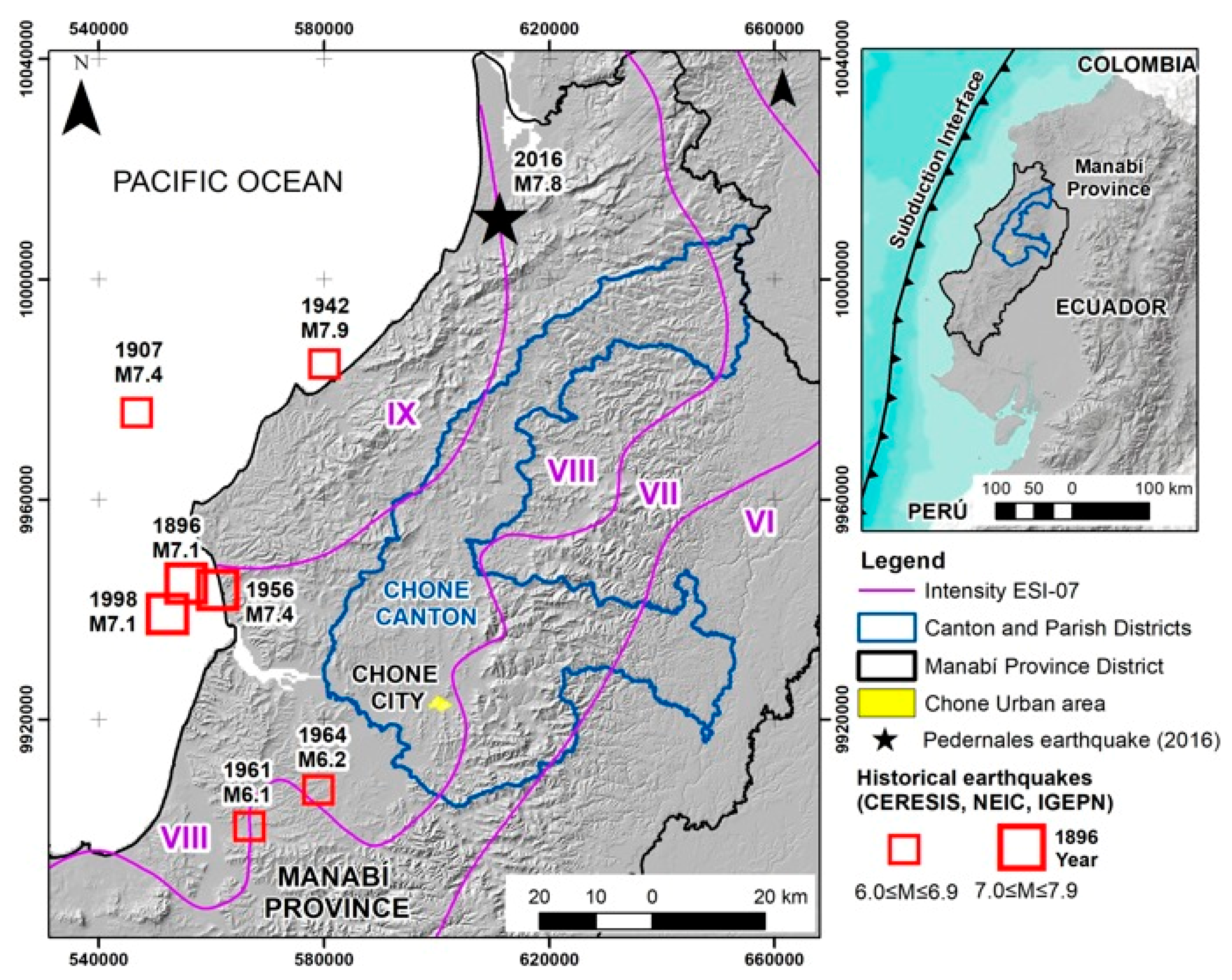
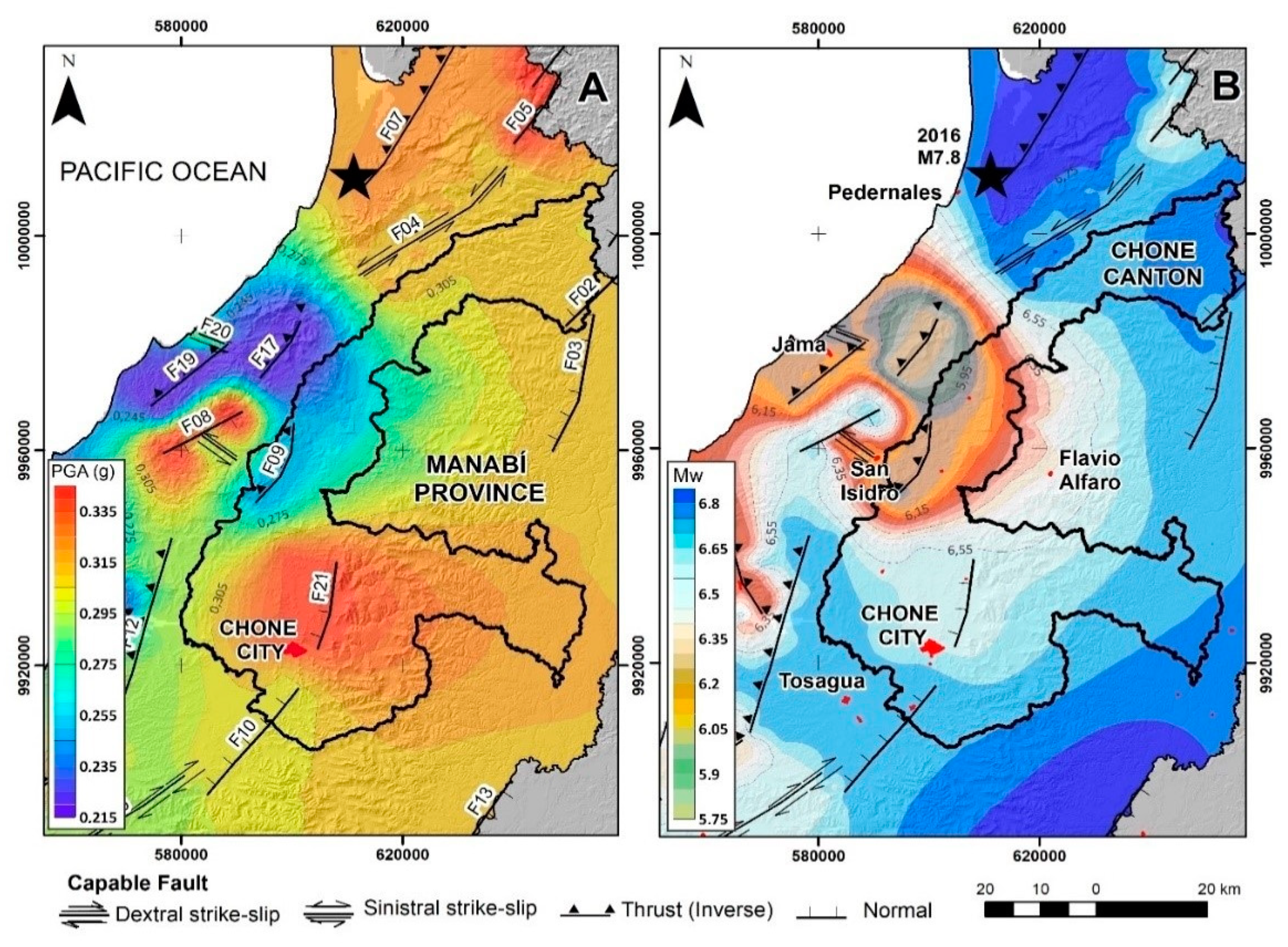

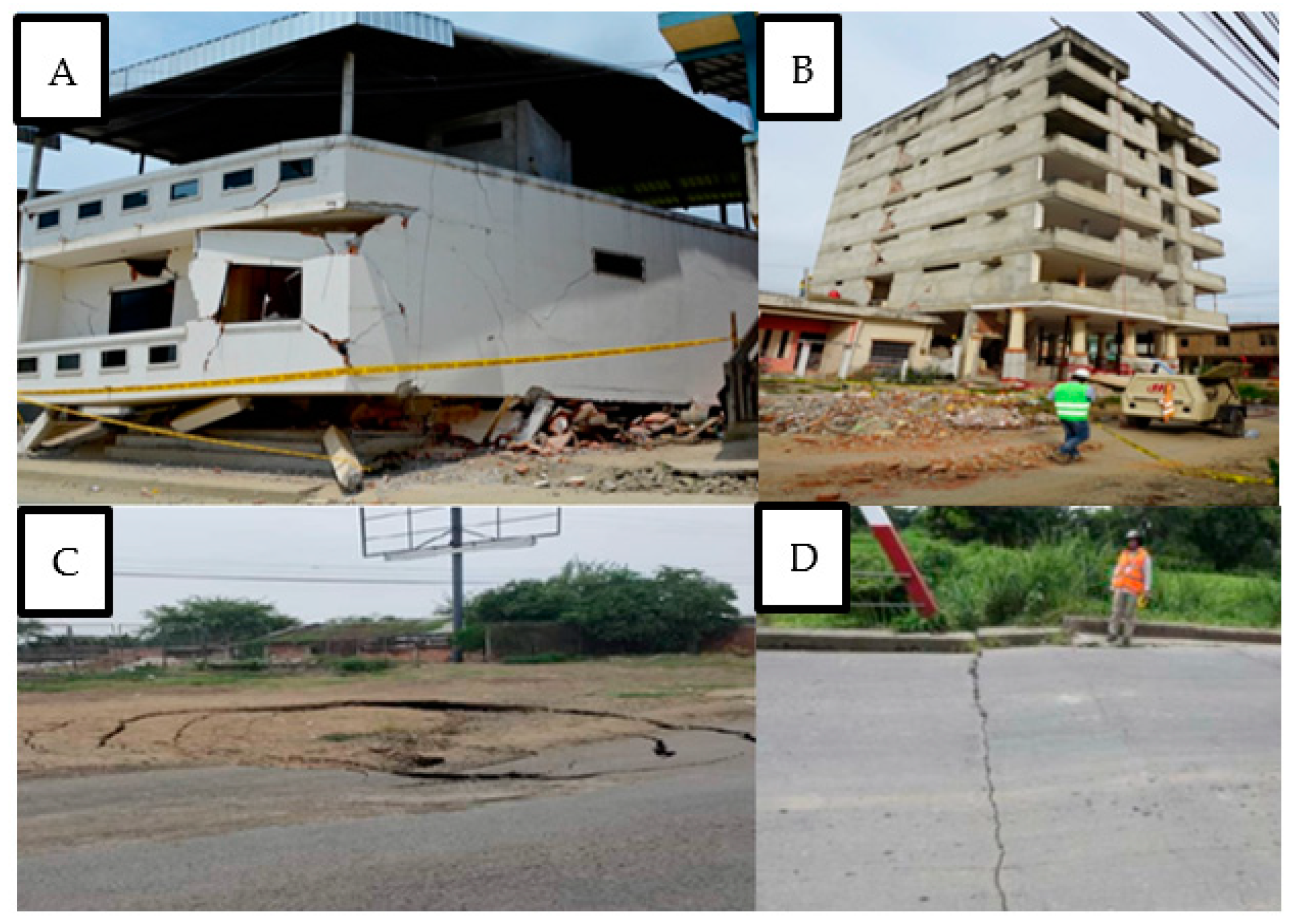

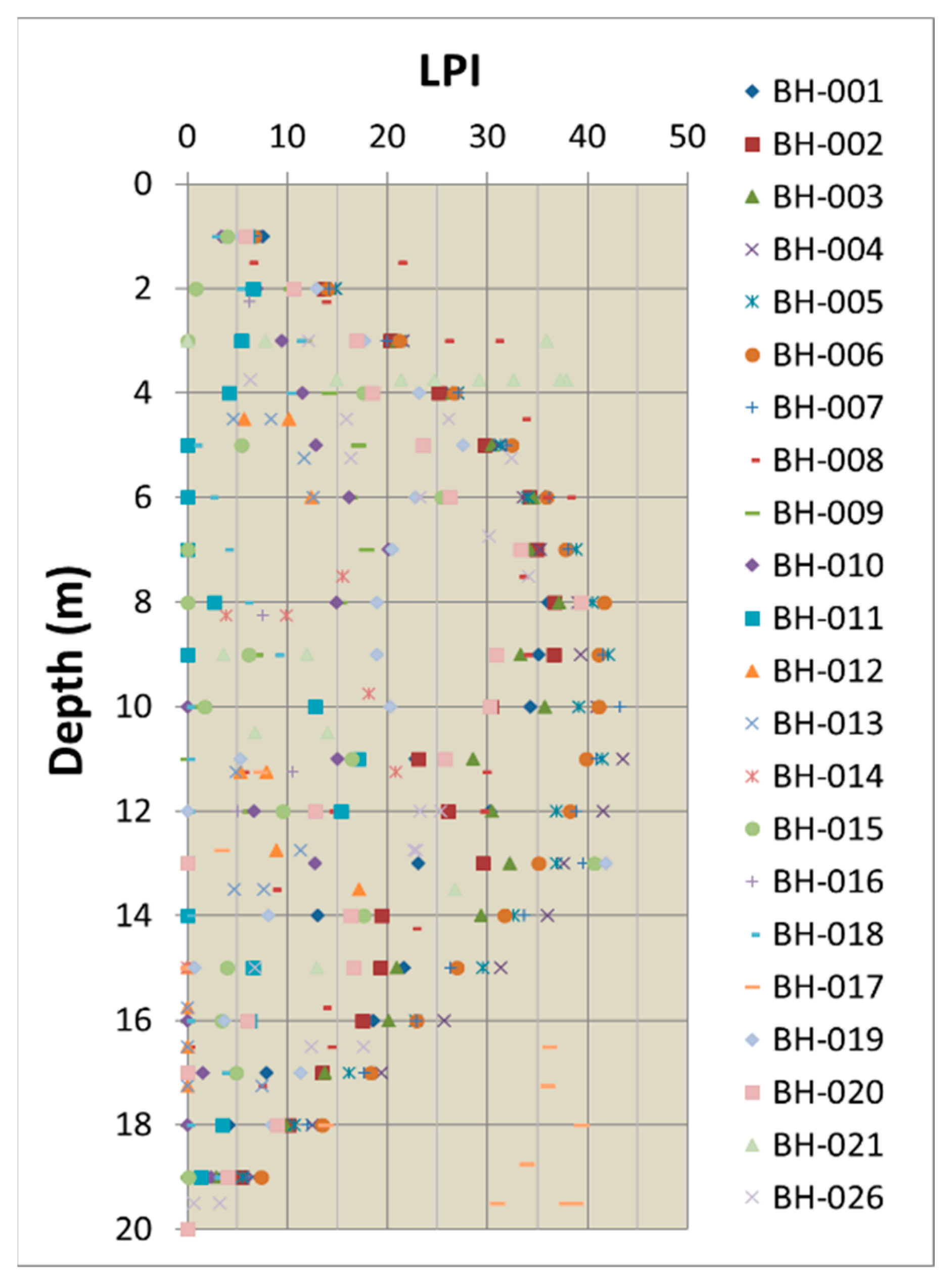
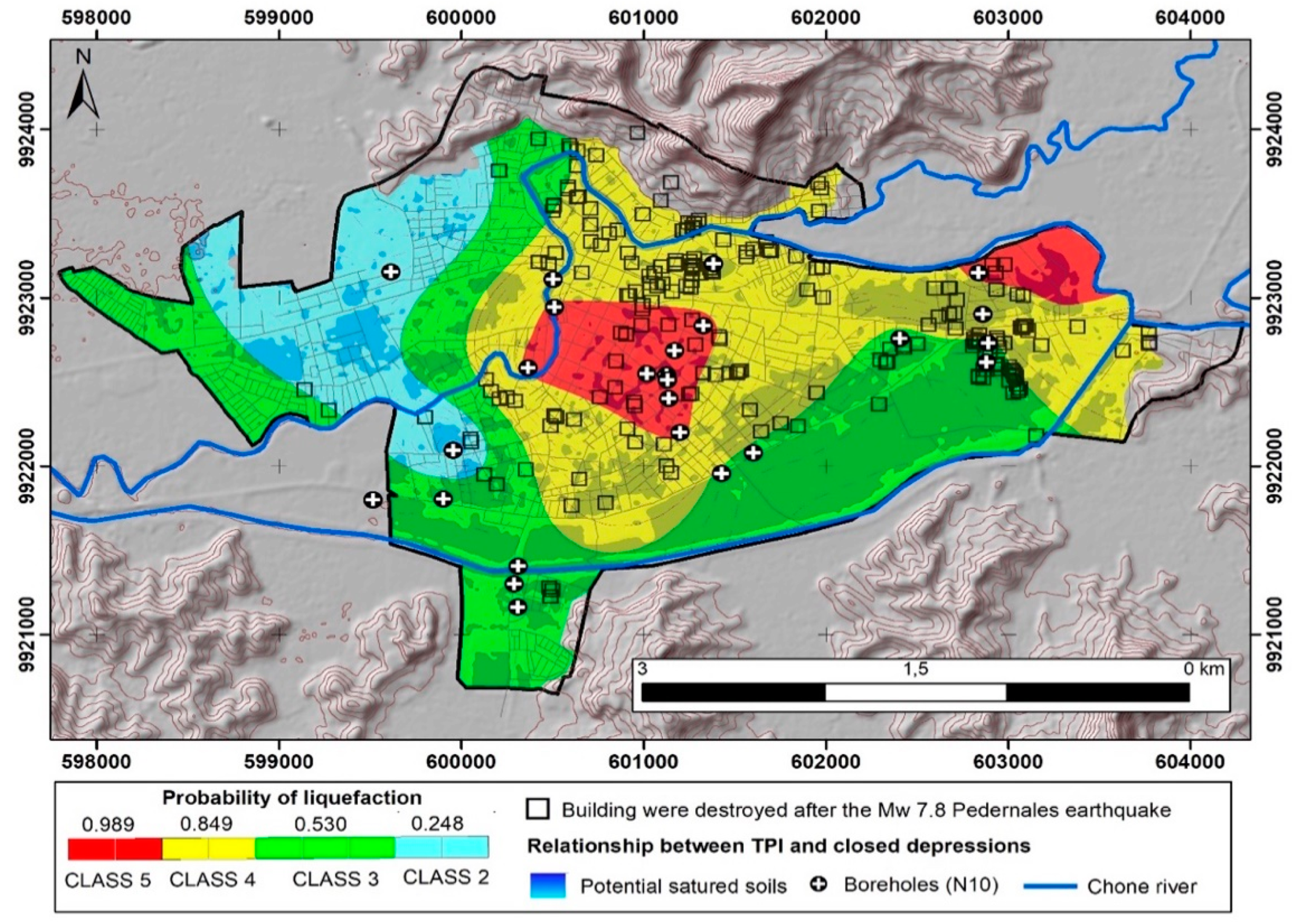
| Geologic Units | Thickness of Sediments | USCS Soil Type | Geological Age | Average Shear Rate (m/s) |
|---|---|---|---|---|
| Alluvium plain deposits | 1 ≤ m ≤ 8 | MH–ML | Holocene | 100–150 |
| Stiff colluvium alluvium | 8 ≤ m ≤ 22 | ML–SM | Holocene to Late Pleistocene | 150–400 |
| Ancient alluvial–colluvial | 15 ≤ m ≤ 18 | MH–SM | Holocene to Late Pleistocene | 180–300 |
| Soft rock siltstone | >25 m | ML–MH | Late Pleistocene | >500 |
| Borehole | Fc | Sr | ρd | LL | IP | N1SPT60 |
|---|---|---|---|---|---|---|
| (%) | (%) | (g/cm3) | (%) | (%) | ||
| Min–Max | Min–Max | Min–Max | Min–Max | Min–Max | Min–Max | |
| Alluvium plain deposits | 6–78 | 96.87–99.87 | 1.307–1.746 | 23–46 | 4–22 | 1–21 |
| Ancient alluvium plain | 16–98 | 80.45–85.56 | 1.566–1.852 | 0–66 | 0–33 | 6–44 |
| Colluvium–lluvium deposits | 15–82 | 77.12–86.54 | 1.654–1.866 | 25–42 | 7–16 | 11–45 |
Publisher’s Note: MDPI stays neutral with regard to jurisdictional claims in published maps and institutional affiliations. |
© 2022 by the authors. Licensee MDPI, Basel, Switzerland. This article is an open access article distributed under the terms and conditions of the Creative Commons Attribution (CC BY) license (https://creativecommons.org/licenses/by/4.0/).
Share and Cite
Ortiz-Hernández, E.; Chunga, K.; Toulkeridis, T.; Pastor, J.L. Soil Liquefaction and Other Seismic-Associated Phenomena in the City of Chone during the 2016 Earthquake of Coastal Ecuador. Appl. Sci. 2022, 12, 7867. https://doi.org/10.3390/app12157867
Ortiz-Hernández E, Chunga K, Toulkeridis T, Pastor JL. Soil Liquefaction and Other Seismic-Associated Phenomena in the City of Chone during the 2016 Earthquake of Coastal Ecuador. Applied Sciences. 2022; 12(15):7867. https://doi.org/10.3390/app12157867
Chicago/Turabian StyleOrtiz-Hernández, Eduardo, Kervin Chunga, Theofilos Toulkeridis, and José Luis Pastor. 2022. "Soil Liquefaction and Other Seismic-Associated Phenomena in the City of Chone during the 2016 Earthquake of Coastal Ecuador" Applied Sciences 12, no. 15: 7867. https://doi.org/10.3390/app12157867
APA StyleOrtiz-Hernández, E., Chunga, K., Toulkeridis, T., & Pastor, J. L. (2022). Soil Liquefaction and Other Seismic-Associated Phenomena in the City of Chone during the 2016 Earthquake of Coastal Ecuador. Applied Sciences, 12(15), 7867. https://doi.org/10.3390/app12157867








